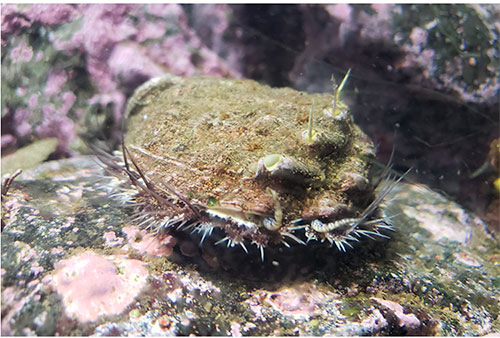Pinto abalone. |
All About Abalone
Abalone are large gastropod mollusks, or large snails, that live in the marine environment. The pinto abalone can grow up to 6 inches in length and has a multicolored, oval shape. The interior of the shell is a beautiful iridescent mother-of-pearl that is used in jewelry and other decorations.
Abalone are found in the cold waters around the world. In Alaska, they need rocky shores and kelp forests to thrive. They are usually found crawling on the sea floor in kelp beds and along rocky beaches.
Sometimes they can be found exposed during extreme low tides.
Abalone are a key part of the Alaskan ecosystem. Their numbers are influenced by other species, including sea otters, sea urchins, and humans. They are found in Alaska from the outside coast of Chichagof Island, south to the Canadian border and east to Ketchikan and Metlakatla.
Community EngagementNOAA Fisheries and Alaska Sea Grant have formed an Alaska abalone working group. It brings together tribal, state, federal, and non-profit partners to discuss a sustainable future for abalone. One aspect of the working group’s efforts is to solicit community input on the species’ recovery and sustainability strategies. Alaska Sea Grant has an open survey to collect information from the public on their interests and thoughts concerning abalone’s importance and potential, including farming.
Ashley Bolwerk has been leading the community engagement initiative through her Alaska Sea Grant fellowship with NOAA Fisheries. She stated, “My goal in doing these community outreach trips and events is to engage with communities to determine what abalone recovery and sustainability strategies they are most interested in seeing in their community. This information can then be used by the abalone working group that I have been facilitating to create goals and objectives.”
Ashley has provided marine science lessons to more than 100 K-12 students in the Hoonah area. She has introduced students to marine species and taught them about pinto abalone’s history and future. She has also connected with tribal partners and others in the community to tackle the working group’s objective of discussing potential strategies for the population.
Quoting a NOAA/Alaska Sea Grant news release, the engagement of community and tribal partners is creating a strong foundation for the abalone working group to lay out long-term strategies for the recovery and sustainability of pinto abalone. NOAA and Alaska Sea Grant are onsidering public workshops, monitoring test sites, habitat suitability modeling, and other avenues of collecting knowledge as potential tools for species recovery and sustainability planning.
To become involved or for more information, contact ashley.bolwerk@noaa.gov.
Edited By: Mary Kauffman, SitNews
Source of News:
NOAA Fisheries
Alaska Sea Grant
Representations of fact and opinions in comments posted are solely those of the individual posters and do not represent the opinions of Sitnews.
Send a letter to the editor@sitnews.us
SitNews ©2022
Stories In The News
Ketchikan, Alaska
Articles & photographs that appear in SitNews are considered protected by copyright and may not be reprinted without written permission from and payment of any required fees to the proper freelance writers and subscription services.
E-mail your news & photos to editor@sitnews.us
Photographers choosing to submit photographs for publication to SitNews are in doing so granting their permission for publication and for archiving. SitNews does not sell photographs. All requests for purchasing a photograph will be emailed to the photographer.

